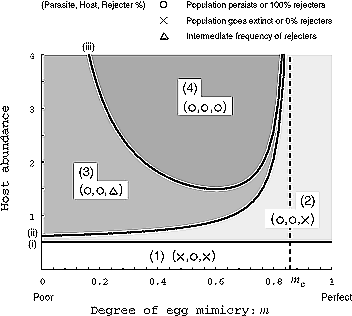Arms Race in Avian Brood Parasitism
Modelling the arms race in avian brood parasitism
Fugo TAKASU
Department of Information and Computer Sciences, Nara Women's University, Nara 630-8506, Japan
Evolutionary Ecology 1998, 12, 969-987.
この論文の一部(日本語)は、日本生態学会誌45巻:191-197(1995)に掲載されました。托卵の共進化に興味のある方の御意見御批判をお待ちしております。
Summary.- In brood parasitism, interactions between a parasite and its host lead to a coevolutionary process called arms race, in which an evolutionary progress in one side provokes a further response in the other side. The host should evolve defensive means to reduce the impact of parasitism, while the parasite should evolve means to counter the host defense. To gain insights into the coevolutionary process of the arms race, a model is developed and analyzed, in which host's defense and parasite's counterdefense are assumed to be genetically determined. First, the effect of parasite counterdefense on the host defense was analyzed. The result shows that a parasite counterdefense can critically affect the establishment of host defense, giving rise to three situations at the equilibrium state: The host shows 1) no defense, 2) an intermediate level of defense, and 3) a perfect defense. Second, evolution of parasite counterdefense was studied in connection with the host defense. The result shows that the parasite can evolve counterdefense to a certain degree, but once it has established counterdefense beyond this degree, the host gives up the defense against parasitism provided the defense entails any cost to perform. Dynamic aspects of selection pressure are crucial for these results. Based on the results, I propose a hypothetical evolutionary sequence in the arms race, along which interactions between the host and parasite proceed.

Fig. Classification of stable equilibrium depending on two parameters, host abundance and level of egg mimicry by parasite. (1) Low host abundance and parasite goes extinct. (2) Host and parasite coexist, but host rejecter individuals do not increase due to cost needed to reject parasitism. (3) Host and parasite coexist, but rejecter individuals increase in frequency only up to a certain level less than 100%. (4) Host and parasite coexist and rejecter individuals are fixed in the host population.
この論文の一部を、第5回国際動物行動学会 ( International Behavioral Ecology Congress, Nottingham, England 14th-20th August 1994) でポスターとして発表したものを PDF形式になおしました。興味のある方はどうぞ御覧になってください。詳しいことは、論文を参照してください。
Poster Title: Host defenses and parasite counterdefenses in avian brood parasitism (136kB in PDF format)
要旨
寄生者は宿主に依存して繁殖し、一般に宿主の繁殖価に悪影響を及ぼす。このような関係の下では両者は、一方の形質の進化がもう片方の進化を促すという軍拡競争型の共進化( Arms Race )をすると考えられている。寄生者の側の進化とは卵擬態など托卵を見破られない形質であり、宿主側の進化とは卵認識などの托卵を見破り拒否する形質である。軍拡競争の考えは共進化の機構を説明する一つの説として有名であるが、その具体的な過程あるいは結末についての理論的考察は未だ少ない
本講演では寄生者の側の進化を考慮に入れた Specialist 系のモデルを発表し、これに基づいて軍拡競争型共進化の可能かつ具体的経路を提示する。寄生者と宿主にかかる選択圧を理論的に考察することによって、寄生者集団中の卵擬態の形質及び宿主集団中の卵認識の形質の広がりについて、以下の結果が導かれる
1)宿主の托卵対抗手段の度合いは宿主の品質と寄生者の卵擬態の程度に強く依存する
2)宿主が托卵対抗手段を示す限り、卵擬態はよりよいものに進化し続けるが、宿主の対抗手段は必ずしも完璧なものにはならない
3)あるしきい値があって、卵擬態の程度がこれを越えると宿主は托卵を拒否しなくなる. このしきい値は宿主の托卵拒否行動にかかるコスト(誤認識など)に依存する
これらを基に、軍拡競争型共進化のたどる可能な道筋を考察し、托卵鳥系の進化について議論する
takasu@ics.nara-wu.ac.jp